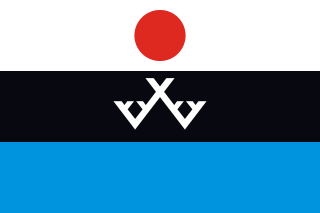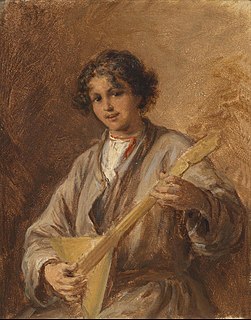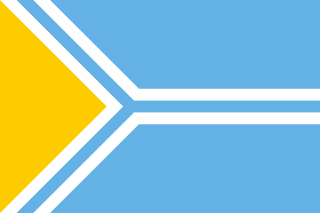
The Evenks are a Tungusic people of North Asia. In Russia, the Evenks are recognised as one of the indigenous peoples of the Russian North, with a population of 38,396. In China, the Evenki form one of the 56 ethnic groups officially recognised by the People's Republic of China, with a population of 30,875. There are 537 Evenks in Mongolia, called Khamnigan in the Mongolian language.

Taymyr Dolgano-Nenets Autonomous Okrug, was a federal subject of Russia, the northernmost in Siberian Russia. It was named after the Taymyr Peninsula. It was also called Dolgan-Nenets Autonomous Okrug, by the name of the indigenous people, Dolgans and Nenetses.
Evenki or Evenk may refer to

Evenk Autonomous Okrug was a federal subject of Russia. On January 1, 2007, it was merged into Krasnoyarsk krai.

Dolgans are an ethnic group who mostly inhabit Krasnoyarsk Krai, Russia. They are descended from several groups, particularly Evenks, one of the indigenous peoples of the Russian North. They adopted a Turkic language sometime after the 18th century. The 2010 Census counted 7,885 Dolgans. This number includes 5,517 in former Taymyr Autonomous Okrug. There are 26 Dolgans in Ukraine, four of whom speak Dolgan.

The flag of Tuva, a republic in the Russian Federation, is a light blue field with a white-fimbriated pall of the same color bordering a yellow triangle on the hoist.

This gallery of flags of federal subjects of Russia shows the flags of the 85 federal subjects of Russia.
Evenk Autonomous Okrug was a federal subject of Russia until December 31, 2006. On January 1, 2007, it was merged into Krasnoyarsk Krai along with Taymyr Autonomous Okrug. During the transitional period it retains a special administrative status within Krasnoyarsk Krai.
Taymyr Autonomous Okrug was a federal subject of Russia until December 31, 2006. On January 1, 2007, it was merged into Krasnoyarsk Krai along with Evenk Autonomous Okrug. During the transitional period it retains a special status within Krasnoyarsk Krai.

Circumpolar peoples and Arctic peoples are umbrella terms for the various Indigenous peoples of the Arctic.

The flag of Chukotka Autonomous Okrug, in the Russian Federation, is a blue field charged with a white triangle at the hoist side. At the center of the triangle is a roundel of the Russian national flag rimmed with a thick yellow border.

The flag of Nenets Autonomous Okrug, in the Russian Federation, is a white field charged with green stripe and a blue ornament strand near the bottom. A blue stripe separates the bottom most green stripe from the ornament.

Evenkiysky District, or Evenkia, is an administrative and municipal district (raion), one of the forty-three in Krasnoyarsk Krai, Russia. Before January 1, 2007, it was split into three different districts - Baykitsky, Ilimpiyskiy and Tungussko-Chunsky - as the Evenk Autonomous Okrug—a federal subject of Russia. It is located in the central and eastern parts of the krai and borders with Taymyrsky Dolgano-Nenetsky District in the north, the Sakha Republic and Irkutsk Oblast in the east, Kezhemsky, Boguchansky, Motyginsky, and Severo-Yeniseysky Districts in the south, and with Turukhansky District in the west. The area of the district is 763,200 square kilometers (294,700 sq mi). Its administrative center is the rural locality of Tura. Population: 16,253 (2010 Census); 17,697 (2002 Census); 24,409 (1989 Census). The population of Tura accounts for 34.1% of the district's total population.

Evenk Autonomous Okrug, or Evenkia, was a federal subject of Russia. It had been created in 1930. Its administrative center was the urban-type settlement of Tura. As of 2006, at 767,600 km2, it was Russia's seventh largest federal subject, and the country's least populous: 17,697 (2002 Census).
Aleksandr Aleksandrovich Bokovikov was a Russian politician and businessman who served as the Governor of the now defunct Evenk Autonomous Okrug from 1997 until 2001. The Evenk Autonomous Okrug was later merged into the Krasnoyarsk Krai on January 1, 2007, and incorporated into the Krasnoyarsk Krai as the Evenkiysky District.
Tungussko-Chunsky district was a former district (raion) of the former Evenk Autonomous Okrug which was merged into Krasnoyarsk Krai on 1 January 2007.
Ilimpiyskiy District was a former district (raion) of the former Evenk Autonomous Okrug which was merged into Krasnoyarsk Krai on 1 January 2007.

The Evenk constituency (No.224) was a Russian legislative constituency in the Evenk Autonomous Okrug in 1993-2007. In 2007 Evenk AO alongside neighbouring Taymyr AO were merged with Krasnoyarsk Krai, so currently the territory of former Evenk and Taymyr constituencies is now a part of Yeniseysk constituency of Krasnoyarsk Krai.












